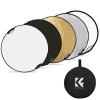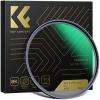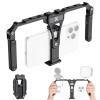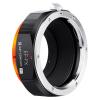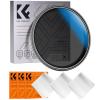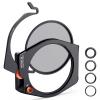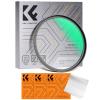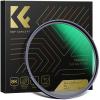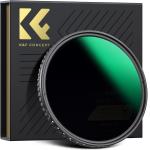
K&F Concept 77mm Variable ND Filter ND8-128 (3-7 Stop) HD Hydrophobic VND Filter for Camera Lens No X Cross Nano-Xcel
SKU: KF01.1079
A
This is ircular polarizer,can darken skies, manage reflections, and suppress glare from water bodies. Rotating a CPL filter on your lens can make dramatic changes to a simple image.
A
Hi, this CPL filter can be screwed on nd filter, but it doesn't support be used on the K&F X-PRO square filter holder
A
Hi, this filter fit 55mm size lens , we checked the nikon af-p dx 18-55mm lens is 55mm size ,this filter can fit it , but please reconfirmed your lens size mark as "Ø" (diameter) symbol, if the number is 55, it would be ok, thanks.
A
The K&F CPL filter is budget friendly but seems to be well made and, in my experience, it does not cast a noticeable tint at all.
However, some cameras may not set the white balance accurately when dark filters are used (such as a 10-stop ND filter). For this reason I prefer to set the white balance manually prior to threading the filter to the lens. This can prevent a color shift and save you the time of having to tweak it in post production.
A
yes, also helps with reflections - eg images reflected on a glass or plastic surface as the polarization eliminates “scattering”
A
Yes. You can attach another filter once it is attached to your lens.
A
It is a "polarizing" filter, so yes, it "just polarizes." That is it's only job really. :) Looking into your question as a whole, to do its job to "just polarize" correctly, yes the visual effect will change as you rotate it. The amount of change will vary with different situations. Many years ago when I was learning "the basics" of filters, the most common use of a polarizing filter was to darken blue skies and to reduce or eliminate reflections in a flat glass surface, like a store window. To do either of these to the maximum effect you need to be thinking like "part of a triangle". If you are trying to darken blue sky, the filter will have different levels of effectiveness depending on where you are pointing your camera in relation to the sun. Here is the method I learned. Turn your hand into a "gun" with your first finger pointing straight ahead with your thumb basically pointing 90 degrees to the side. Using your gun hand, point your finger at the sun. Wherever your thumb is pointed or can point if you were to rotate your wrist right or left are the areas of the sky that will darken the most with the polarizing filter.
To reduce or eliminate "window glare" the best angle to stand looking at the glass is approx. 37 degrees. This means that the polarizing filter will not reduce the reflection if you are shooting straight into the window. You have to turn and shoot at an angle. All of this means that the polarizer is not a silver bullet. It will not work at all in some situations, and will be more effective or less effective in situations described above.
A
yes, on both sides of the filter
A
yes, on both sides of the filter
A
For the Nikon 7200 you need a filter in the size 67 mm, this also applies to all lenses.

